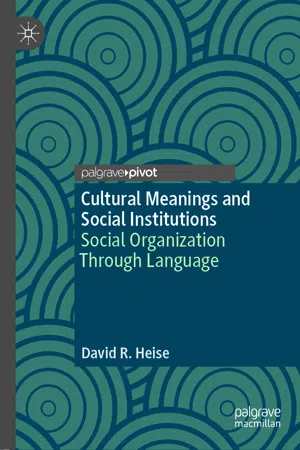Societal functions are performed by people in interconnected roles accomplishing standard actions within venues that have needed instruments and supplies. Examples include families breakfasting, physicians examining patients, lawyers conferring with clients, teachers querying students, and clergy conducting funerals. An enculturated individual understands what is going on in each such locale and can participate when that individual has an operative role-identity in the situation .
Navigating between societal functions involves defining situations in order to choose interconnected role -identities for self and others. For instance, an individual entering a building labeled as a hospital is primed to expect medically related interactions. When encountering someone, the individual searches among hospital identities—such as doctor, nurse , patient , visitor , or staffer—while attending to cues such as attire or verbalizations like “I’m Doctor Fix” in order to find the interconnected role-identities best suited for other and self—doctor–patient, nurse–doctor, or visitor–staffer, etc. Then social interaction is constructed within the framework of the interrelated roles.
Contemporary civilizations contain thousands of
role -identities, and each person has hundreds of identities for the
self (
MacKinnon and Heise
2010),
so settling on an immediate set of operative identities, with agreement across individuals at the scene, can be challenging. The claim here is that individuals manage to define
situations and perform
societal functions through their implicit
knowledge of social institutions, which allows them to recognize the locales, actors, and actions that they encounter, thereby foregrounding a manageable number of role-identities for self and others in the given situation. Every institution comprises a body of knowledge that
defines the institutionalized areas of conduct and designates all situations falling within them. It defines and constructs the roles to be played in the context of the institutions in question. Ipso facto, it controls and predicts all such conduct. Since this knowledge is socially objectivated as knowledge, that is, as a body of generally valid truths about reality, any radical deviance from the institutional order appears as a departure from reality. Such deviance may be designated as moral depravity, mental disease, or just plain ignorance . (Berger and Luckmann 1966: 83)
Individuals enact societal functions by jointly applying their institutional knowledge , settling on an institutional frame, embodying selected role -identities, and undertaking actions associated with their role assignments.
This account proposes that individuals’ knowledge of social institutions works as a bridge between individual definitions and societal functioning. Anthropologist Goodenough (1961: 522) formulated these two poles as two cultures : “culture 1, the recurring patterns [social structure and social process] which characterize a community as a homeostatic system, and culture 2, people’s standards for perceiving, judging, and acting. Culture 1, moreover, is an artifact or product of the human use of culture 2. … Individuals can be said to possess culture 2 but not culture 1, which is the property of a community as a social ecological system.” In Goodenough’s framework social institutions correspond to “disparate public cultures,” where a public culture consists of “perceptual and conceptual features embedded in the meanings of the vocabulary of language and other public symbols ,” plus shared knowledge and beliefs, shared conventions, rules, and recipes regarding behavioral activities, and a shared value system. “The more complex the community or society , then the greater the number of disparate public cultures which are likely to obtain and the fewer the number of situations and contexts for which there is a public culture pertaining to the society as a whole” (Goodenough 1961: 524).
Berger and Luckmann (1966: 92–93) also considered the duality of shared knowledge and societal functioning. “Institutions’ linguistic objectifications, from their simple verbal designations to their incorporation in highly complex symbolizations of reality, … represent them (that is, make them present) in experience. And they may be symbolically represented by physical objects, both natural and artificial. All these representations, however, become ‘dead’ (that is, bereft of subjective reality) unless they are ongoingly ‘brought to life’ in actual human conduct. The representation of an institution in and by roles is thus the representation par excellence.” For Berger and Luckmann , shared knowledge is the quintessence of social life, and language is the means for creating and maintaining knowledge. “Language objectivates the shared experiences and makes them available to all within the linguistic community , thus becoming both the basis and the instrument of the collective stock of knowledge. Furthermore, language provides the means for objectifying new experiences, allowing their incorporation into the already existing stock of knowledge, and it is the most important means by which the objectivated and objectified sedimentations are transmitted” (Berger and Luckmann 1966: 85–86). Because “language and the cognitive apparatus based on language, … orders [the world] into objects to be apprehended as reality” (Berger and Luckmann 1966: 84), institutional worlds are experienced as objective realities, even though originating from verbalizations about activities that were emergent solutions to joint problems.
These classic statements linking individual knowledge , subjective culture , and social institutions imply that individuals have knowledge about social institutions—an hypothesis that needs to be verified empirically in order to ground understanding of how individual action becomes societal functioning. In principle, one might demonstrate that individuals have knowledge of social institutions by undertaking a testing program on a probability sample of individuals from a national population in order to show (or disprove) that most individuals do know the key participants, actions, and contexts that are associated with each major social institu...
